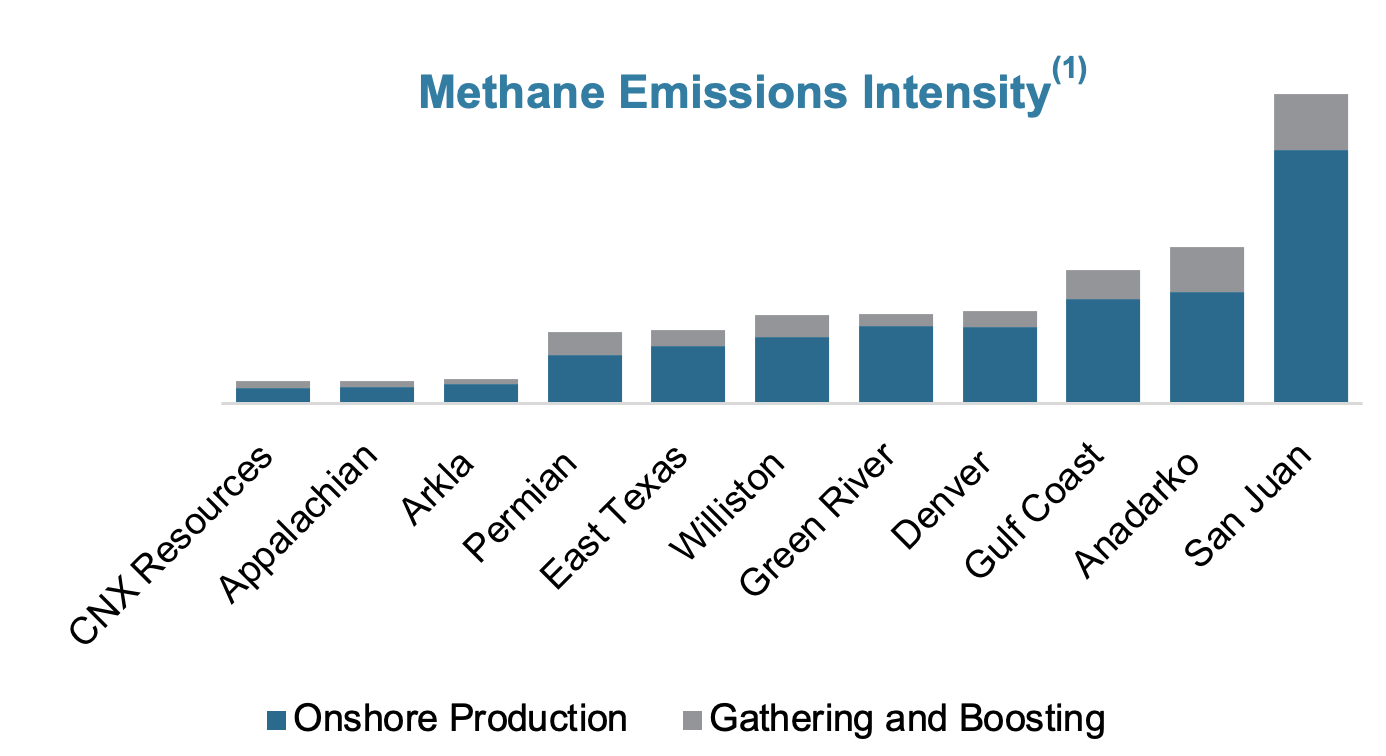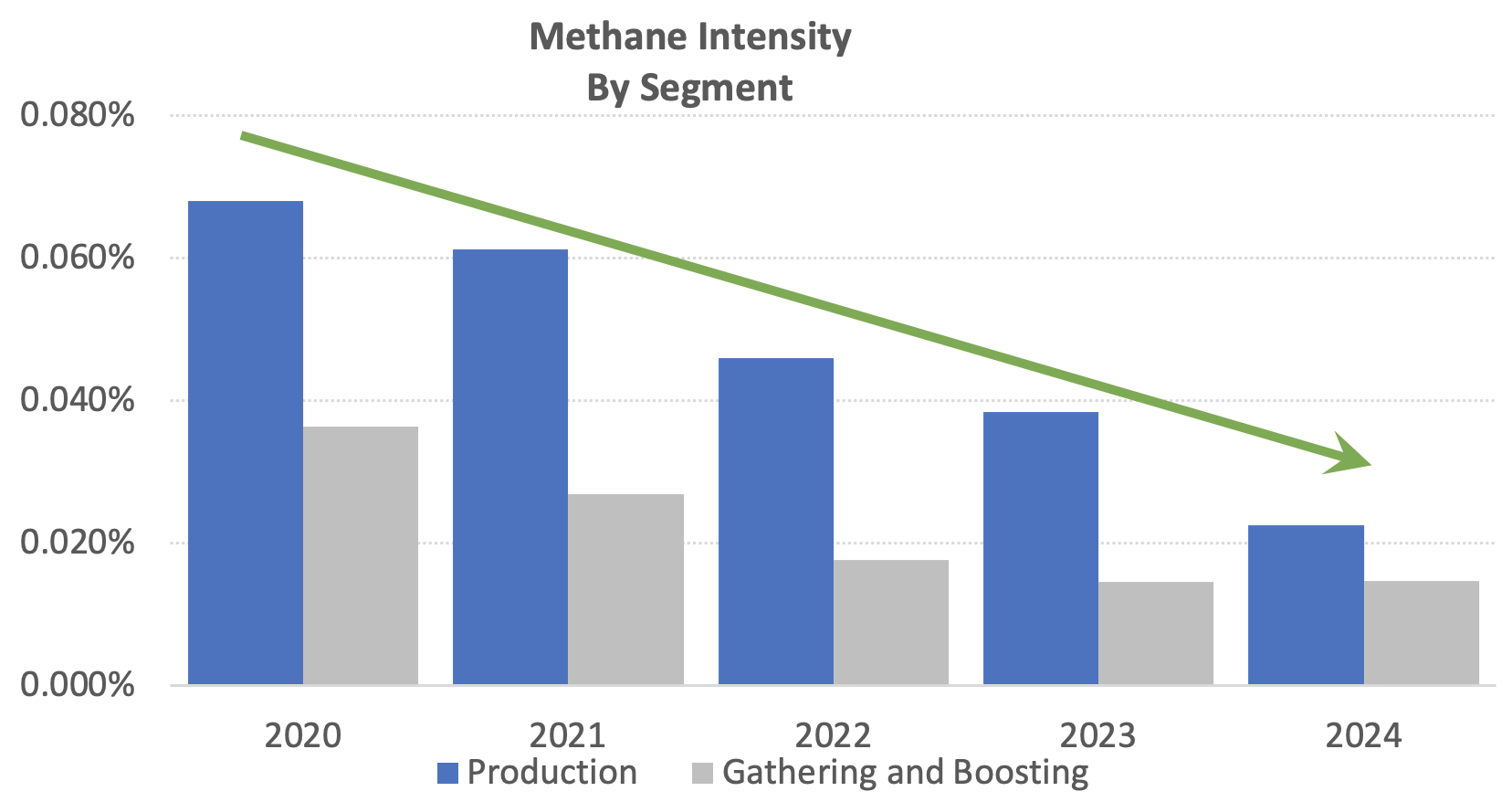Mitigating Methane – Basin Leading in the Leading Basin
Results of unique methane reduction efforts maintain company’s position as the leader in the lowest emission basin in the United States
March 13, 2023

By Hayley Scott, CNX Chief Risk Officer
Natural gas is the catalyst for a more sustainable future. No fuel has contributed more to our country’s leadership in emission reductions than natural gas. Replacing higher emitting fuels with this resource produced safely in the Appalachian Basin is the best option to meet growing energy demand while enhancing environmental progress.
The Appalachian Basin is the lowest methane emission intensity basin in the United States, and CNX is a leader in the basin in driving meaningful methane emission reductions.

Since 2021, executive compensation has been tied to annual methane intensity reduction targets through our Long-Term Incentive program, thereby explicitly linking pay to ESG performance. For the second straight year, CNX has outperformed against these targets – and due to the strength of our team and their commitment to innovation and continuous improvement, we are confident that we can achieve our future milestone reduction goals by focusing on efficiency and utilizing new technology.
We have established an Emission Reduction Task Force (ERTF) consisting of members from various operational, environmental, engineering, and data management teams to focus on reduction of CNX’s methane emissions. The ERTF meets regularly to prioritize opportunities with the greatest potential to impact CNX’s overall emission footprint.
Since 2020 through the end of 2022, we have produced 2 quadrillion BTUs of life-sustaining energy (which is enough equivalent energy to power 8 million homes per year) while reducing our operational methane intensity by 32% in our production segment and by 52% in our gathering and boosting segment.
In 2023, we have committed to allocate $7 million of capital investment to methane reduction efforts. This capital will be used to make changes to our pneumatic devices and our liquids unloading procedures that we expect to result in an annualized methane reduction of 70,000 tons CO2e by the end of the year. The resulting projected methane intensities maintain our position as a leader in the lowest emission basin in the United States.

Future goals through 2024 are to reduce both our production and our gathering and boosting segment methane intensities to approximately 0.020% or lower. This would result in approximately 67% and 59% reductions, respectively, since 2020.
In addition to our operating methane emission reductions, CNX actively reduces methane emissions from other industries through our waste methane abatement initiatives. We capture approximately 5.7 million tons of waste methane CO2e, which is significantly more methane than we emit from our operating activities. This is residual waste methane that is otherwise vented to atmosphere during the mining process. Methane emissions from mining activities represent nearly 10% of all U.S. methane emissions. Instead of releasing this methane to atmosphere, CNX captures, processes, compresses, and transports this waste methane to market for beneficial use – one of only a handful of such projects in the nation.
“Appalachia can be the launchpad to a more efficient and sustainable future catalyzed by lower carbon intensity natural gas. This proud region and its people should be the solution to deliver reliable and affordable energy – our region's abundant energy resources can and must be used more effectively to prioritize the improvement of the human condition, the environment, the nation, and the world,” said Yemi Akinkugbe, CNX Chief Excellence Officer.
CNX continues to drive improvements to our operating workflows, practices, and procedures in production and midstream operations to go beyond regulatory requirements. We seek to achieve much earlier detection of fugitive emissions and mitigate leaks at the source, expeditiously.
We utilize multiple early detection devices such as drone technology and OGI camera surveys and we are piloting new technologies such as satellites and passive ground detection systems.
In addition, CNX’s Regulatory Reporting Group is responsible for enhancing our regulatory and environmental compliance data management processes. Given the importance of environmental data integrity and transparency and validation of emissions data, we created this new team devoted to non-financial regulatory data gathering, validation, and reporting. As evidenced by our first-of-its-kind quarterly emissions report, this has improved the timeliness, reliability, and accuracy of our reports providing emissions data to stakeholders and improving our environmental performance as we utilize the data in our operations. We intend to share best practices with peer companies developing similar processes to help lead the domestic energy industry in this important arena.
Please visit our Corporate Responsibility Report to learn about our commitment to environmental stewardship and local responsibility (we anticipate publishing our 2022 report in the second quarter of this year).
Our Appalachia First strategic vision is a plan for the future that embraces innovation and harnesses the talent, resources, and opportunities of Appalachia to transform our region, nation, and the world.
Hayley F. Scott is CNX Resources Corporation’s Chief Risk Officer. Scott is responsible for the management and governance necessary to identify, evaluate, mitigate and manage CNX’s strategic, operational, compliance, and reputational risks.
You May Also be Interested In...


